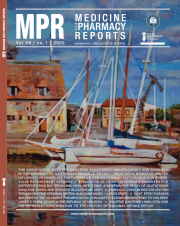Patient - prosthesis mismatch and its influence on immediate postoperative Von Willebrand factor levels in aortic valve replacement surgery
DOI:
https://doi.org/10.15386/mpr-2811Keywords:
patient-prosthesis mismatch, aortic valve replacement, Von Willebrand factor, prosthetic valve sizeAbstract
Background and aims. Aortic stenosis (AS) often requires surgical aortic valve replacement (SAVR). Patient-prosthesis mismatch (PPM) can lead to suboptimal outcomes. Von Willebrand factor (VWF), crucial for hemostasis, is altered in AS patients. As part of an ongoing study, this research focuses on the impact of PPM on immediate postprocedural VWF levels in SAVR patients, building upon our previous publication on short-term VWF dynamics in SAVR and TAVR.
Methods. This prospective study included 31 consecutive patients with severe AS undergoing SAVR. Preoperative and postoperative VWF levels were measured. PPM was assessed based on the indexed effective orifice area of the implanted valve.
Results. PPM was observed in 61.29% of patients. Postoperative VWF antigen levels increased significantly (131.37 ± 64.82 IU/dL to 311.01 IU/dL, p<0.01). However, PPM did not significantly influence postoperative VWF antigen levels (285.43 IU/dL vs. 293.30 IU/dL, p=0.88), VWF activity (178.33% vs. 204.76%, p=0.56), or Factor VIII levels (100.38 IU/dL vs. 97.10 IU/dL, p=0.79).
Conclusions. While SAVR led to increased VWF levels, PPM did not impact short-term VWF dynamics. This study provides insights into PPM and VWF relationships in SAVR patients, informing valve selection and perioperative management strategies. A future paper will reveal long-term follow-up results, completing this comprehensive investigation of VWF dynamics in aortic valve interventions.
Downloads
Published
How to Cite
Issue
Section
License
The authors are required to transfer the copyright of the published paper to the journal. This is done by agreeing to sign the Copyright Assignment Form. Whenever the case, authors are also required to send permissions to reproduce material (such as illustrations) from the copyright holder.

The papers published in the journal are licensed under a Creative Commons Attribution-NonCommercial-NoDerivatives 4.0 International License.

